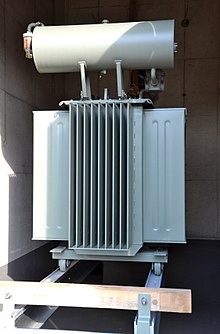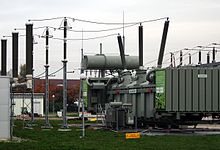Transformer oil


Transformer oil or insulating oil is a highly refined mineral oil or a low-viscosity silicone oil that is stable at high temperatures. It is used in high-voltage technology in transformers , capacitors and switches for insulation , spark quenching , lubrication (e.g. on the tap changer ) and for cooling (e.g. in power electronics ).
General
The oil in the transformer housing of oil-insulated transformers is used both for insulation of the windings and for cooling. The cross section of the winding wires is limited due to the limited winding space. Therefore, electrical heat is generated inside the winding. Large transformers are much more efficient than small ones, but the heat inside the windings is more difficult to get to the outside. The oil filling improves the heat transfer and also fills all gaps, so that the insulation is also improved.
The oil releases the heat by convection to the transformer housing, which in turn has cooling fins or heat exchangers similar to radiators on the outside . Large transformers also have fans to cool the heat exchangers.
Insulation faults in the windings are healed to a certain extent by washing away decomposition products. This phenomenon is monitored with a Buchholz relay attached to the expansion tank by registering the gases produced in the oil. With the Buchholz protection, insulation faults can be detected at an early stage and the risk of fire can be reduced.
One disadvantage, however, is the oil's flammability at high temperatures. The considerable amount of oil creates a high fire load . Oil lots transformers, so-called dry-type transformers are usually with epoxydharzisolierten windings ( resin transformer built). However, this insulation does not have any self-healing properties and has a lower electrical strength and poorer cooling properties. Another method to reduce the risk of fire was for a time (1960s) to use polychlorinated biphenyls (PCB) or polychlorinated terphenyls (PCT) as insulating oil or to add to it. These oils have excellent insulating properties, are less flammable or non-flammable, but are poisonous even when they come into contact with the skin and, because of their lack of degradability in the environment, have been banned in existing systems from a content of 50 ppm since 1999 .

As an environmentally friendly alternative to PCB, but also as a substitute for classic mineral oil , synthetic organic esters have been used in transformers for over 25 years . These are saturated pentaerythritol tetra fatty acid esters , which are characterized by a high fire point (> 300 ° C), flash point (> 250 ° C) and a high ignition temperature (> 375 ° C) and, like PCBs, are therefore difficult to ignite. In addition, the ester liquid is non-toxic, easily biodegradable and classified as not hazardous to water. The insulating properties are comparable to those of mineral oil, which is conventionally used as insulating oil in transformers, and to those of PCB.
Another property of the ester liquid is its higher thermal resistance compared to mineral oil. This is due to the thermally more stable ester groups. Due to the higher thermal resistance of synthetic organic esters as an insulating liquid, it is possible to build transformers smaller and more compact and to operate them with higher power. Higher operating temperatures are possible, which is particularly important for traction transformers (e.g. locomotive transformers ).
The insulation system of a large distribution or machine transformer consists of solid insulation, cellulose paper wrapped around the conductor and an insulating liquid such as mineral oil or ester liquid. The water content in a transformer has a significant influence on the dielectric strength and the service life or service life of a transformer. In the transformer, water leads to the hydrolysis of the cellulose paper and thus to a lowering of its degree of polymerisation . For this reason, "breathing" transformers have a dry cartridge that extracts water from the ambient air before it comes into contact with the insulating oil. Hermetically sealed transformers have no direct contact with the environment. Despite these measures, all transformers contain water in the ppm range. This comes from the cellulose (contains approx. 1% water when dried), from aging processes ( oxidation of the insulation materials) and from the ambient air, because the drying cartridge does not completely remove the water from the air, especially when the transformer cools down quickly. Even a closed transformer is never completely isolated from the ambient air over its entire service life.
Due to the different polarities of cellulose (e = 5.1) and mineral oil (e = 2.2), most of the water is in the solid insulation. Due to their molecular structure, esters are more polar (e = 3.3) than mineral oil and have a significantly higher water solubility (ester: 2700 ppm at 20 ° C; mineral oil: 44 ppm at 20 ° C). When using ester liquid as an insulating and cooling liquid in the transformer, the water equilibrium is different from that of mineral oil. Significantly more water is dissolved from the cellulose by the ester liquid. By reducing the water in the cellulose, its hydrolysis and thus the aging of the insulation system is slowed down and the operating life of the transformer is extended.
Individual evidence
- ↑ Product information sheet from Siemens for epoxy resin encapsulated large transformers from the GEAFOL brand (PDF; 376 kB)
- ↑ GEAFOL reference list from Siemens
- ↑ State Working Group Waste (LAGA): Leaflet Technical Requirements for the Cleaning and Disposal of Transformers with PCB-Containing or PCB-Contaminated Mineral Oil-Containing or Synthetic Isolation Fluid - Hesse - from December 1, 1999 ( Memento from December 22, 2010 in the Internet Archive )
- ↑ Siemens manufactured the world's first large transformer with vegetable oil. ( Memento of the original from October 24, 2016 in the Internet Archive ) Info: The archive link was inserted automatically and has not yet been checked. Please check the original and archive link according to the instructions and then remove this notice.
- ↑ Product information sheet for insulating and cooling liquid based on a synthetic organic ester BecFluid 9902 from Beck Electrical Insulation GmbH .